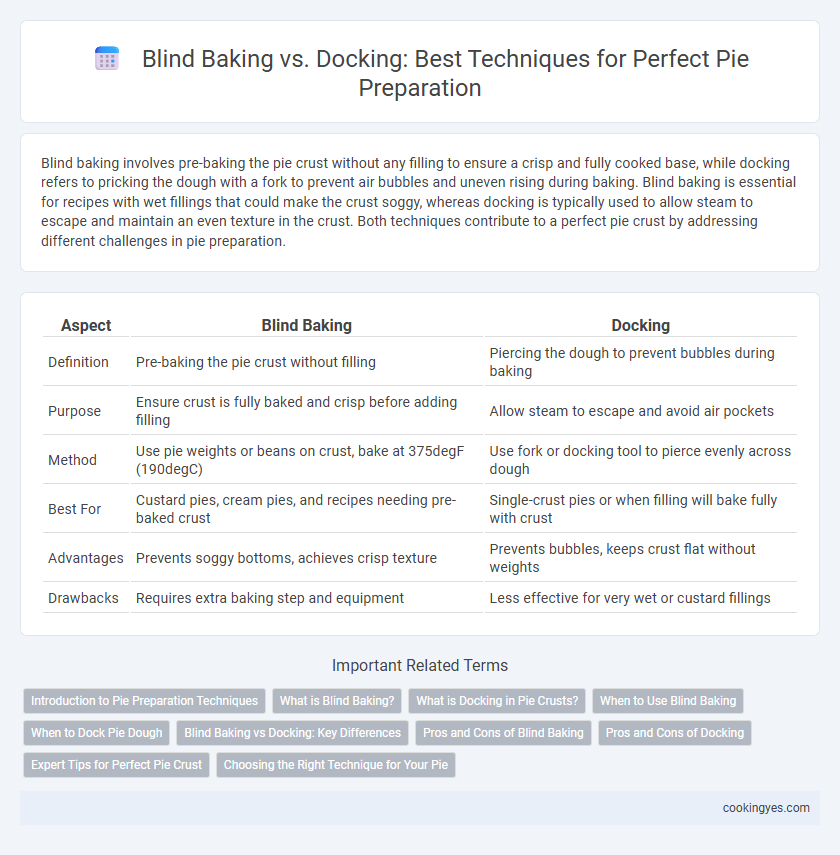Blind baking involves pre-baking the pie crust without any filling to ensure a crisp and fully cooked base, while docking refers to pricking the dough with a fork to prevent air bubbles and uneven rising during baking. Blind baking is essential for recipes with wet fillings that could make the crust soggy, whereas docking is typically used to allow steam to escape and maintain an even texture in the crust. Both techniques contribute to a perfect pie crust by addressing different challenges in pie preparation.
Table of Comparison
| Aspect | Blind Baking | Docking |
|---|---|---|
| Definition | Pre-baking the pie crust without filling | Piercing the dough to prevent bubbles during baking |
| Purpose | Ensure crust is fully baked and crisp before adding filling | Allow steam to escape and avoid air pockets |
| Method | Use pie weights or beans on crust, bake at 375degF (190degC) | Use fork or docking tool to pierce evenly across dough |
| Best For | Custard pies, cream pies, and recipes needing pre-baked crust | Single-crust pies or when filling will bake fully with crust |
| Advantages | Prevents soggy bottoms, achieves crisp texture | Prevents bubbles, keeps crust flat without weights |
| Drawbacks | Requires extra baking step and equipment | Less effective for very wet or custard fillings |
Introduction to Pie Preparation Techniques
Blind baking involves pre-baking the pie crust without filling, ensuring a crisp, fully cooked base ideal for wet fillings like custards or fruit. Docking is the technique of piercing the dough with a fork before baking to prevent air bubbles, suitable for pies where the filling is added after partial baking or fully baked with the crust. Both techniques are fundamental for achieving optimal texture and preventing sogginess in various pie recipes.
What is Blind Baking?
Blind baking is a pie crust preparation technique where the crust is baked without any filling to ensure a crisp and fully cooked base. It prevents the crust from becoming soggy when wet fillings are added later, especially important for custard or cream pies. Typically, the crust is lined with parchment paper and filled with pie weights to maintain its shape during baking.
What is Docking in Pie Crusts?
Docking in pie crusts involves pricking the dough with a fork or docking tool to create small holes that allow steam to escape during baking, preventing the crust from puffing up and ensuring an even bake. This technique is essential for blind baking, where the crust is baked without filling to maintain its shape and texture. Proper docking results in a crisp, flat pie base ready for fillings that require no further baking.
When to Use Blind Baking
Blind baking is essential for pies with wet or custard fillings, such as cream pies or quiches, to prevent a soggy crust by fully pre-cooking the pastry. It is particularly useful when the filling requires little or no baking time, ensuring the crust remains crisp and structurally sound. This technique involves lining the dough with parchment and filling it with pie weights to avoid puffing and shrinkage during baking.
When to Dock Pie Dough
Docking pie dough is essential when preparing a pie crust that requires blind baking to prevent bubbles by allowing steam to escape during baking. It is particularly important for custard pies, quiches, or any filling poured into a pre-baked crust, ensuring an even, flat surface. Avoid docking for fruit pies where the filling will release moisture, as the steam naturally vents through the filling.
Blind Baking vs Docking: Key Differences
Blind baking involves pre-baking a pie crust with pie weights to prevent bubbling and ensure a crisp texture, while docking refers to piercing the dough with a fork to allow steam to escape during baking. Blind baking is essential for custard or cream pies requiring a fully cooked crust before filling, whereas docking is typically used for pies that bake with filling to avoid uneven rising. Understanding these techniques improves pie crust texture and prevents sogginess, enhancing overall pie quality.
Pros and Cons of Blind Baking
Blind baking a pie crust ensures a crisp, fully cooked base ideal for custard or cream fillings, preventing sogginess caused by wet ingredients. It requires using pie weights or dried beans to avoid puffing, which can add preparation time and cleanup complexity. Overbaking risks a too-browned crust, while underbaking can result in a soggy center, demanding careful monitoring during baking.
Pros and Cons of Docking
Docking a pie crust involves creating small holes to allow steam to escape, preventing bubbles and uneven rising during baking. This technique helps maintain a flat crust, ideal for pies with wet fillings, but may result in a less tender and crisp texture compared to blind baking. Docking is faster and less labor-intensive but offers less control over browning and structural integrity than blind baking.
Expert Tips for Perfect Pie Crust
Blind baking involves pre-baking the pie crust with pie weights to ensure a crisp, even base for custard or cream pies, preventing sogginess. Docking creates small holes in the dough with a fork to allow steam to escape, reducing air bubbles and ensuring a flatter crust for fruit pies. Experts recommend combining docking with blind baking when using a moist filling to achieve a perfectly textured and flaky pie crust.
Choosing the Right Technique for Your Pie
Blind baking involves pre-baking the pie crust to ensure a crisp, fully cooked base, ideal for custard or cream pies that require no further baking. Docking, the process of poking small holes in the dough, prevents air bubbles and uneven rising during baking, best suited for fruit-filled pies where the crust is baked along with the filling. Selecting blind baking or docking depends on the pie filling type, desired crust texture, and baking time, ensuring a perfectly cooked pie every time.
Blind Baking vs Docking for Pie Preparation Infographic

 cookingyes.com
cookingyes.com